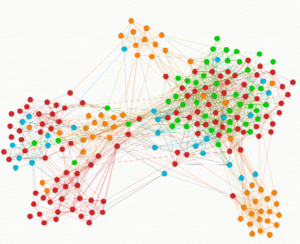Effective Strategies for Intentional Collaboration in the New World of Work
Posted: July 26, 2023
 In today’s fast-paced and ever-changing work landscape, organizations must innovate boldly and execute with speed to remain competitive. This requires a new way of working that actively facilitates collaboration and connections among team members, regardless of their location or working arrangements.
In today’s fast-paced and ever-changing work landscape, organizations must innovate boldly and execute with speed to remain competitive. This requires a new way of working that actively facilitates collaboration and connections among team members, regardless of their location or working arrangements.
We need to become more intentional in how and where we collaborate. One study suggests that teams that are more intentional about how and where they collaborate are 2.2 times more productive, according to Gartner. As defined by the Connected Commons, intentional collaboration emphasizes the significance of connections in facilitating both innovation and execution within organizations. It leverages a teaming perspective that prioritizes distinct types of connections to enable specific business outcomes.
A teaming approach provides a more dynamic response that supports a team to more actively adapt its connections and collaboration practices to facilitate outcomes. In other words, the connections necessary to discovering new ideas is different than the connections necessary to bring those ideas to life. As a result, teams need to adapt their collaboration practices to better facilitate their desired outcomes. Just think of it this way, the way you discover new technology is different than integrating that technology into a new product. Each, requires a distinct set of collaborative practices. We believe these practices are best determined and managed at a team level.
Adaptive Teaming
Adaptive teaming is a collaborative approach in which teams intentionally come together, shift, and reform based on the specific needs and challenges of a project or task. It involves the ability to quickly assemble diverse expertise, leverage collective intelligence, and adapt to changing circumstances. This approach emphasizes the permeability of team boundaries and the need for teams to be well connected to key stakeholders in the broader organization.
Adaptive teaming enables organizations to effectively respond to complex and rapidly changing environments, driving innovation, problem-solving, and successful execution. It can help us to address the challenges of hybrid work by focusing on the flow of work and the need for teams to rapidly establish relationships inside and outside the group. The four intentional collaboration modes that help facilitate the various practices of adaptive teaming are discovery, development, diffusion, and delivery.
Discovery Collaboration Mode
In the discovery phase, teams are focused on identifying new opportunities and exploring potential solutions. This is where lateral bridging connections are critical, as team members must be able to share ideas and insights freely and collaborate effectively to identify the most promising opportunities. The discovery process is often inhibited by siloed structures that limit access to new insights. Research shows that if these bridging connections aren’t nurtured, new ideas will stop flowing. In one case, employees spent 24% less time on idea generation when bridging connections deteriorated.
Intentional collaboration emphasizes the importance of creating connections across different teams and functions to ensure that diverse perspectives and insights are brought to bear on the problem at hand. The discovery collaboration mode also focuses on outside connections and learning. It enables teams to tap into a wider pool of knowledge, experiences, and perspectives. It helps teams avoid insular thinking, stimulates creativity, and fosters a culture of continuous learning and adaptation. By actively seeking external insights, teams can discover new opportunities, challenge assumptions, and improve their problem-solving capabilities in a rapidly changing environment.
Intentional discovery positions team members to more fully leverage their collective intelligence, diverse perspectives, and network expertise to generate new ideas and insights. Such intentionality is crucial in a rapidly changing and uncertain environment because it allows organizations to adapt and respond more rapidly to emerging challenges and opportunities.
Development Collaboration Mode
However, new ideas are not enough. These ideas need to be brought to life. The development phase is where ideas are transformed into tangible products, solutions or services. This phase requires bonding connections, or close collaboration within a team to design, build, and test new solutions. Intentional collaboration emphasizes the importance of creating connections with team members that have complementary skills and expertise to ensure that the product or service being developed is robust, effective, and meets the needs of customers.
In the development collaboration mode, small teams engage in local bonding interactions to facilitate idea elaboration and refinement. These interactions are designed to foster trust and positive affect, which are crucial components of creativity and development. High levels of trust within cohesive groups facilitate active learning and speed, enabling the rapid development of new solutions.
Intentional collaboration for development enables teams to more fully leverage individual capabilities, skills, and experiences to build out solutions quickly. It promotes idea iteration and refinement, resulting in the development of high-quality solutions and projects that can effectively resolve challenges and opportunities.
Diffusion Collaboration Mode
Local solutions have limited impact unless they are scaled more broadly. Research shows that ideas that are developed within cohesive teams are 43% more likely to be rejected by the broader organization. Intentional diffusion is essential to getting solutions more widely disseminated across the organization. It involves moving concepts, knowledge, and products beyond a core team or project to facilitate broader usage, scale, and greater adoption. Diffusion is the process of taking new solutions and spreading them throughout the organization, it is an essential part of the innovation process.
This requires connections across different teams and functions to share solutions across the broader organization. It also requires vertical bridging interactions to facilitate intentional collaboration with key stakeholders, decision-makers, and thought leaders across the organization who can contribute to the successful diffusion and implementation of ideas.
Fostering intentional collaboration ensures that knowledge and solutions are shared, resources are leveraged, and stakeholders are actively engaged, resulting in successful scaling and adoption of ideas that contribute to organizational adaptation and success.
Delivery Collaboration Mode
The delivery work mode is a crucial aspect of adaptive teaming that focuses on executing and implementing proven solutions at the individual level, or sometimes within larger teams. This phase requires deep focus for individuals, often complementing strong team collaboration, to ensure that issues are identified and addressed quickly. It involves setting clear goals, establishing team roles and responsibilities, ensuring efficient execution, and maintaining regular communication and feedback to drive successful delivery.
This phase often emphasizes a heads-down focus on work that enables productivity. Interruptions and distractions need to be minimized. Intentional collaboration is limited to working together towards common milestones that drive the successful execution of projects or initiatives. These bonding interactions are designed to ensure that the team is focused on achieving clear goals, establishing team roles and responsibilities, and ensuring productivity. Regular communication and feedback are also essential to driving execution.
Enabling Adaptive Teaming
To enable this new way of working, organizations must intentionally collaborate within and across each of these four modes of collaboration. An adaptive teaming approach helps an organization to focus expertise, knowledge, and diverse perspectives of individuals and teams. It also promotes the right type of collaboration to facilitate innovation, and effective execution in a dynamic environment by intentionally aligning collaboration activities to the designed outcomes of the four modes. In other words, intentional collaboration practices are leverage to create a form-follows-function approach. That is, specific interactions are designed to achieve the desired function or business outcome.
Just consider the case below of a large, maturing technology company. The organization has been incredibly successful over the past decade, but has become growingly concerned about its ability to generate new innovations as it dedicates more time to the scaling and delivery of current services. This concern is magnified based on the recent success of a couple competitors in the artificial intelligence (AI) space. As a result, one division within the company deployed an intentional collaboration method using the adaptive teaming model and then validated its approach with a network analysis.
Figure 1 below highlights these findings. The analysis highlights the primary collaboration mode for each person, the green nodes demonstrate a focus on discovery, the orange on development, the blue on diffusion and finally, the red on delivery. The first thing to notice is that two of the three big bets that are being incubated as future AI innovations are well positioned for collaborative success. The first being the orange cluster of nodes at five o’clock, with the second one being the orange cluster at twelve o’clock. These small, cohesive teams are well positioned to rapidly iterate and develop out AI solutions with great velocity and focus.

That was not true for the third bet, a larger cluster of various color nodes near nine o’clock is much more mix-mode in nature. That is, this bet includes individuals that are focused on development, diffusion, and delivery. Upon review, this was not a major surprise for the technology company as this bet was not performing as well as the other two. This third bet emerged from an existing product team and was therefore tightly coupled with the current solution.
While this group was able to quickly influence others to get their new ideas into existing products, this was at the expense of slowing down the overall development process. Based on the prevailing collaboration practices, team members were often distracted and pulled away on more urgent issues. The result, was unsatisfactory progress on this bet.
Finally, the division also recognized another major collaboration challenge. The large blob of green, red and some blue nodes in the upper right was also operating in mixed-mode. At first glance this seemed promising as these individuals represented a well-integrated group of sales, customer solutions, marketing, and customer service professionals. The challenge was that most of the new discovery for the division was coming from these teams. While that was beneficial for improving current products and solutions, the firm believes it stifled the new learning necessary to aggressively advance on the AI front.
Intentional Collaboration Actions
As a result of the organization’s strategy and the findings from the network analysis on adaptive teaming, the technology division decided to take three additional actions.
Stratify out the development team for the third bet. The firm recognized that this bet needed to be separated from the current product delivery team to ensure more rapid iterations, deeper focus, and limited distractions. The desired outcome is to improve innovation velocity.
Create an advanced strategy team. The firm also recognized that too much of the discovery collaboration was coming from the operators of the current product line. The result was a less aggressive view on possibilities of future growth bets. As a result, the firm created a dedicated strategy team focused on larger discoveries and longer-term possibilities.
Invest in future scaling connections. While the firm was satisfied with the progress of bets number one and two, they recognized a future need for scaling beyond the development teams into the broader organization when the solutions seemed promising. As a result, they began to build out some diffusion practices to more tightly connect these two teams to other core influencers to position themselves to scale faster in the future.
The combination of these actions and an ongoing focus on intentional collaboration will help to prepare this company for the new world of work.
By Michael Arena
Originally posted on HR Exchange Network
